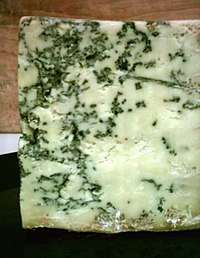
Photo from wikipedia
Filamentous fungi are an important source of natural products. The mold Penicillium roqueforti, which is well-known for being responsible for the characteristic texture, blue-green spots, and aroma of the so-called… Click to show full abstract
Filamentous fungi are an important source of natural products. The mold Penicillium roqueforti, which is well-known for being responsible for the characteristic texture, blue-green spots, and aroma of the so-called blue-veined cheeses (French Bleu, Roquefort, Gorgonzola, Stilton, Cabrales, and Valdeón, among others), is able to synthesize different secondary metabolites, including andrastins and mycophenolic acid, as well as several mycotoxins, such as Roquefortines C and D, PR-toxin and eremofortins, Isofumigaclavines A and B, festuclavine, and Annullatins D and F. This review provides a detailed description of the biosynthetic gene clusters and pathways of the main secondary metabolites produced by P. roqueforti, as well as an overview of the regulatory mechanisms controlling secondary metabolism in this filamentous fungus.
Journal Title: Journal of Fungi
Year Published: 2023
Link to full text (if available)
Share on Social Media: Sign Up to like & get
recommendations!